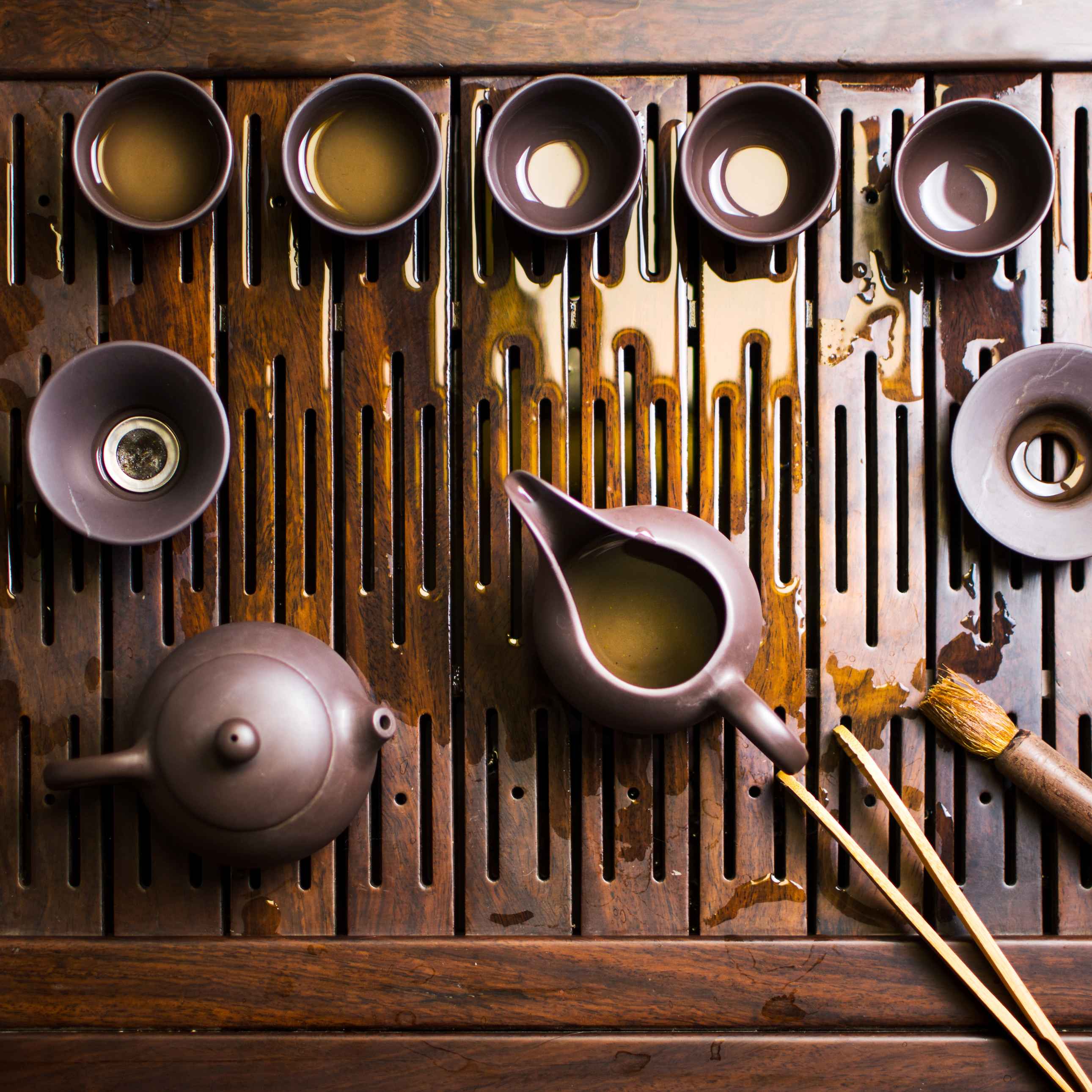
This article is part 2/3 of our gongfu tea series. Here we will give a detailed overview of the tools and teaware used, as well as offer a step-by-step guide to the ceremony.
In case you are still new to the concept of gongfu tea, then please take a look at part 1/3 of our series for an introduction.
Tools and teaware
At its most basic, to perform a gongfu style brew, you only need a kettle, teapot and drinking cup. Indeed, these tools would allow us to control all the parameters necessary for a gongfu style brew. However, it would be far too basic to be considered a ceremony. Over generations of refinement, many additional tools have been incorporated, both for function and flare, and therefore some more essential than others. This, along with the regional differences that exist, make it a commonly accepted notion that there isn’t one correct method to perform a gongfu tea ceremony. Finally, oftentimes aesthetically pleasing items, such as runner cloths, candles, flowers, or even music, may be added to the ceremony in order to fully complete the Chá Xí (茶席).
- Kettle (水壺 Shuǐ Hú): Used to boil water. Traditionally, a cast iron kettle over hot coal was the chosen method. Today, an electronic kettle with a temperature control setting is popular.
- Teapot (茶壺 Chá Hú): Used to brew the tea leaves. Should be made from clay for optimal heat-retention. However, when brewing white, yellow or green teas, a ceramic or glass teapot is preferred in order to prevent overheating the leaves. Size should be 100-200ml.
- Fairness cup (公道被 Gōng Dào Bēi): Used to decant the tea liquor from the teapot and ensures everybody gets an equal strength brew. Can be any vessel, often a small pitcher. Also known as a Chá Hǎi (茶海), which translates to “sea of tea”. Optional when brewing solo.
- Fragrance cup (聞香杯 Wén Xiāng Bēi): Tall and thin cup. Not used for drinking, but for sniffing the remnant aromas of the tea liquor after it has been poured into the tasting cup. Also known as a sniffing cup or an aroma cup. Size must match the tasting cup. Optional.
- Tasting cup (品茗杯 Pǐn Míng Bēi): Used for drinking. Usually around 35-100ml.
- Tea saucer (茶托 Chá Tuō): Used to catch spills. Can be elongated (when holding both fragrance and tasting cups) or circular (when only holding tasting cup). Optional.
- Tea tray (茶盤 Chá Pán): Used to catch overflow and spills. The teapot, fairness cup, fragrance cups and tasting cups are all placed on top the tea tray when being filled. For catching water, the tray either has a removable receptacle, or a hose that drains into another receptacle. Should be emptied only once the ceremony has finished.
- Tea jar (茶罐 Chá Guàn): Used for long-term storage of dry tea leaves. Must be airtight and preferably non-transparent.
- Tea lotus (茶荷 Chá Hé): An unlidded container used to first display the dry tea leaves, and then to slide these into the teapot. Often made from bamboo. Optional.
- Tea cannister (茶筒 Chá Tǒng): Used to hold the following six utensils: spoon, tongs, needle, brush, scraping spoon and awl. Optional.
- Tea spoon (茶匙 Chá Chí): Used to transfer dry tea leaves from the tea jar onto the tea lotus (if used), or directly into the teapot. Prevents damaging and contaminating the dry tea leaves. Optional.
- Tea tongs (茶夾 Chá Jiā): Used to handle hot teaware, improve hygiene and add flare. Optional.
- Tea needle (茶針 Chá Zhēn): Used to clear the teapot spout if it gets clogged with leaves. Optional.
- Tea brush (茶筆 Chá Bǐ): Used to evenly spread tea and water spills across the teaware and tray. Prevents tea stains forming unevenly. Optional.
- Scraping spoon (刮匙 Guā Chí): Used to empty wet leaves from the teapot. Optional.
- Tea awl (茶錐 Chá Zhuī): Used to break compressed tea into manageable chunks. Sometimes a tea knife is preferred instead. Optional.
- Funnel (漏斗 Lòu Dǒu): Used to prevent spilling dry tea leaves during their transfer from the tea lotus to the teapot. Optional.
- Tea strainer (茶漏 Chá Lòu): Used to filter out any small pieces of tea leaf and other impurities when transferring the tea liquor from the teapot to the fairness cup. Optional.
- Tea pet (茶寵 Chá Chǒng): Used to prevent splashing when discarding rinse water or excess tea. Waste liquid is poured directly on top of the tea pet, rather than onto the flat surface of the tea tray. Some tea pets change colour or eject water when coming into contact with hot water. Considered a lucky charm. Optional.
- Tea towel (茶巾 Chá Jīn): Used to wipe spills. Usually a dark colour.
Gongfu tea ceremony
The ceremony itself contains equal parts show and practicality. The process of pouring the tea from the teapot, into the fairness cup, into the fragrance cups, and lastly into the tasting cups may be performed with some flare; however, it also serves to cool the tea and spread its aromas. A skillful tea master will simultaneously entertain, brew a good tea, and create a contemplative atmosphere, with the ultimate aim of making his guests become aware of the Chá Qì (茶氣), or tea energy.
Below we have outlined a step-by-step guide to the tea ceremony as it is performed in Taiwan. Certain steps which are self-evident, such as when to use the tea towel to wipe spills or tea needle to unclog the spout, have been left out for the sake of brevity. Below are the minimum number of steps necessary.
- Boil the water.
- Pre-heat the teaware. Pour boiling water into the teapot until full, then from the teapot into the fairness cup, then from the fairness cup into the fragrance cups, and finally from the fragrance cups into the tasting cups.
- Discard the hot water. Use the tongs to handle the tasting cups and discard the hot water into the tea tray. If any hot water remains in the fairness cup, then also discard it into the tea tray. You do not need to use the tongs to handle the fairness cup.
- Add dry tea leaves from the tea lotus into the teapot. Use the tea spoon to gently push the tea leaves from the tea lotus into the teapot. If the teapot has a particularly small opening, use the funnel to assist.
- Smell the dry tea leaves in the teapot. The dry tea leaves begin to release their aroma once they come into contact with the pre-heated teapot. Allow your guests to enjoy the smell by passing around the teapot.
- Rinse the dry tea leaves. Heat up water to the temperature required for that tea. Pour this hot water into the teapot. Wait for 5-10 seconds. Now, same as step 2, pour the rinse water from the teapot into the fairness cup, then from the fairness cup into the fragrance cups, and finally from the fragrance cups into the tasting cups.
- Discard the rinse water. Same as step 3.
- First steep. Heat up water to the temperature required for that tea. Pour this hot water into the teapot until overflowing. Now, an optional step is to use the teapot lid to gently push away any tea foam and small pieces of tea leaf that may have floated to the surface. Place the lid on the teapot. Pour more hot water over the exterior of the teapot. Follow the steeping time required for that tea.
- Pour the tea liquor into the fairness cup. Place the tea strainer into the fairness cup first.
- Pour the tea liquor into the fragrance cups. Pouring is done from left to right. If the fragrance cups are not yet full and there is tea liquor remaining in the fairness cup, then repeat the process going back from right to left. Try to do this whole process as one fluid motion. Once the tea liquor has been poured, place the tasting cups upside down over the fragrance cups. According to tradition, discard any tea liquor remaining in the fairness cup into the tea tray. In our opinion, this part seems somewhat wasteful and we believe it is also acceptable to offer re-fills, poured directly from the fairness cup into the tasting cups.
- Smell the fragrance cup. In order to do this, flip the fragrance cup and tasting cup upside down. The tasting cup which was acting as the lid is now at the bottom. Slowly lift up the fragrance cup and let the tea liquor pour into the tasting cup. Immediately bring the now empty fragrance cup to your nose and enjoy the aroma.
- Drink from the tasting cup. The aim is to finish the tea in three gulps. The Chinese character for ‘to taste, to savour’ is 品 (Pǐn), which is composed by repeating the Chinese radical ‘mouth’ 口 (Kǒu) three times. Slurping is allowed, even encouraged, as it helps cool and aerate the tea liquor for full olfactory appreciation. The tasting cup must be held with three fingers: the thumb and index finger hold the sides, whilst the middle finger supports the bottom.
- Additional steeps. Repeat steps 8 to 12. Keep going until the flavour of the tea liquor starts to fade or turn bitter. Keep the lid off the teapot in between steeps to prevent stewing the leaves.
- Thank your guests. This concludes the ceremony.
Now that we've covered the tools and teaware, and have an understanding of the steps involved in the ceremony, we can move on to part 3/3, where we will give our opinion as to whether or not gongfu brewing your tea is the best way to brew.
-
What's next?
Can't wait to put your newly acquired knowledge into practice? Or already have some experience with gongfu brewing? In either case, for those of you who want to take their gongfu sessions to the next level, we recommend trying a Dong Fang Mei Ren or Hong Yu. As these teas are loosely rolled, they infuse faster and will therefore require your full gongfu master focus.
Subscribe and get US$10!
Did you enjoy reading this article? Perhaps even learn something new? If so, we'd love it if you joined our newsletter so that we can occasionally reach out to let you know about our fresh tea harvests and new educational content. Also, we'll send you a US$10 discount coupon as a thank you for joining!

Leave a comment